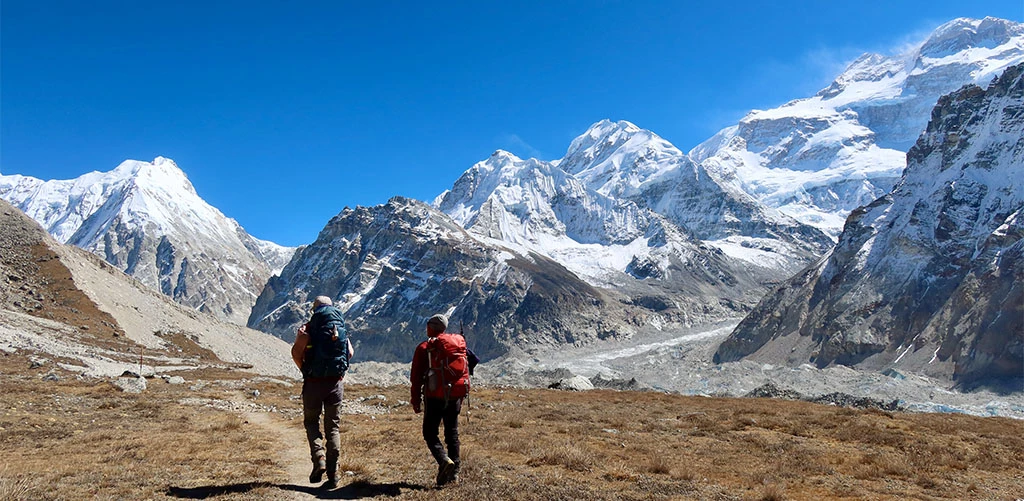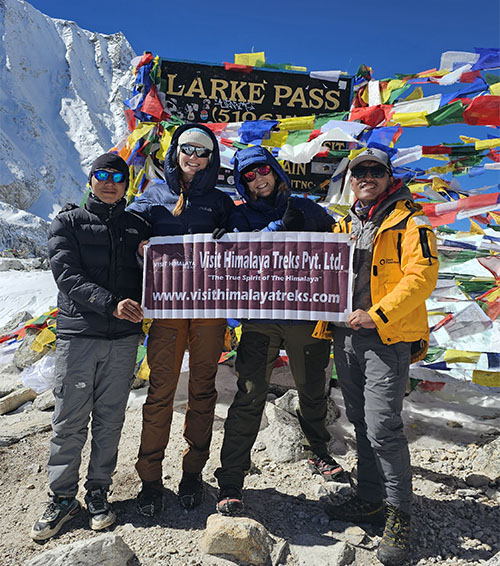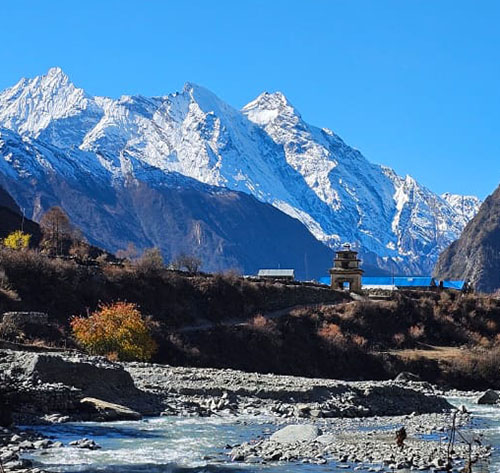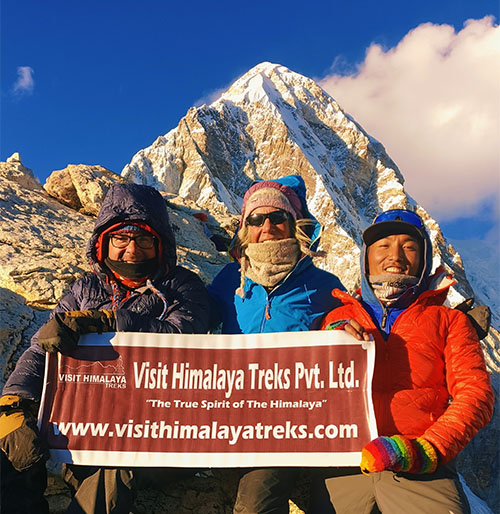In Nepal Himalayan adventures, the Kanchenjunga Base Camp Trek is a hidden jewel offering trekkers looking for solitude and pristine wilderness with an unforgettable adventure. Named after Kanchenjunga, the world's third-highest mountain, this trek offers an unbeatable adventure through isolated communities, verdant rhododendron woods, and stunning alpine scenery. Because the route of Kanchenjunga Base Camp Trek winds through traditional Limbu and Rai communities, it offers trekkers an opportunity to experience the local people's distinct way of life and customs.
This Trek carries the majestic feel of eastern Nepal. There are two primary routes for the trek: the Kanchenjunga North Base Camp and the South Base Camp. Each of these routes has unique perspectives and challenges. The North Base Camp provides stunning vistas of the soaring Kanchenjunga range. On the other hand, the South Base Camp is well-known for its up-close views of the glacier and the amazing Yalung Kang. Combining the unique characteristics of two distinct base camps into one incredible voyage, this dual experience is what makes the Kanchenjunga Base Camp Trek exceptional.
The route also highlights wildlife as it passes through the Kanchenjunga Conservation Area, which is home to endangered animals like red pandas and snow leopards. With its outstanding natural beauty and rich cultural diversity, Kanchenjunga Base Camp Trekking is a paradise for anyone looking for an adventure highlighting every element of Eastern Nepal.
Historical and Cultural Importance.
The Kanchenjunga Base Camp Trek digs deeply into Nepal's eastern cultural and historical past. Following this route will take you through places that are home to the Limbu and Rai communities, whose history is closely connected with their heritage. Trekkers get friendly welcomes and the opportunity to witness age-old customs and traditions as they make their way through traditional communities. The Limbu individuals, for example, are well-known for their unique rituals and colorful cultural festivals, such as the Chasok Tangnam festival, which honours the gods and the harvest time. Beyond all, the Kanchenjunga region's historical significance is noteworthy.
Kanchenjunga, "Five Treasures of Snow," reflects the mountain's holy importance among the locals. The treasures are symbolic of gold, silver, grain, valuable stones, and sacred texts that are thought to be concealed inside the mountain's five summits. Trekkers will come across many monasteries, prayer wheels, and mani walls along the route, all of which relate tales of Buddhist devotion and Himalayan folklore, demonstrating this spiritual admiration. The trek also sheds light on the historic trade routes that previously connected Tibet and India with Nepal, resulting in an intersection of commercial and cultural connections. Experience a world where history and culture are inextricably linked with the Kanchenjunga Base Camp Trek - a rare chance to gain insight into a very culturally rich environment.
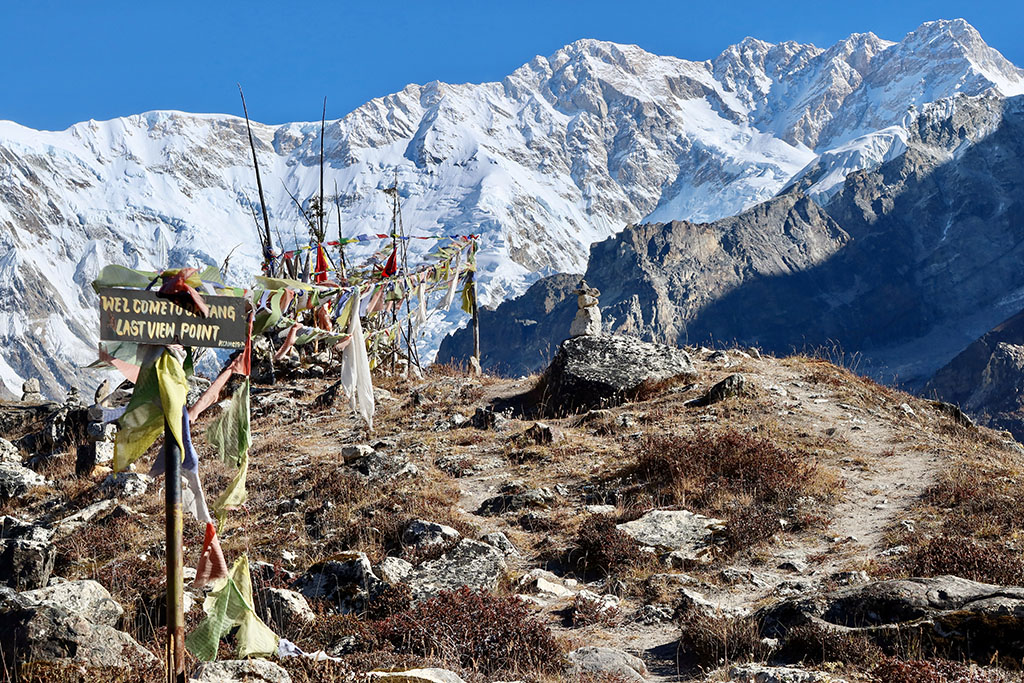
Breathaking Kanchenjunga South View from Oktang View Point.
Distinct features of Trek.
The Kanchenjunga Base Camp Trek is notable for its distinctive features. It provides an outstanding level of a state of isolation making it ideal for anyone looking for an off-the-beaten-path adventure. Unlike popular routes, it is less busy. There are two primary routes for the trek: the North Base Camp and the Kanchenjunga South Base Camp. This twin-route system delivers an array of vistas and sensations. The North Base Camp provides excellent views of the Kanchenjunga range. Trekkers, however, get a close-up view of the Yalung Glacier from the South Base Camp. There are distinct rewards and obstacles on each route.
Trekkers proceed through high mountain passes, alpine meadows, and beautiful rhododendron woods. The Kanchenjunga Conservation Area enhances the trek's attractiveness. Rare species of animals like red pandas and snow leopards call it home. This area has extraordinary biodiversity. The best parts are the cross-cultural interactions. Trekkers get to know the Rai and Limbu individuals while experiencing their warm hospitality and diverse customs. The spiritual dimension is equally significant. There are several monasteries and chortens en route to the holy mountain. The route combines historical significance, cultural richness, and scenic beauty. Trekking through one of Nepal's most unspoiled areas is an unforgettable experience.
Starting point of the Kanchenjunga Base Camp Trek.
Taplejung is a small hilly town which is the main starting point for the Kanchenjunga Base Camp Trek. Taplejung, located in eastern Nepal, is accessible via a flight from Kathmandu to Bhadrapur (Jhapa) and a roadway from Bhadrapur to TaplejungGateway town to Kanchenjunga Base Camp, which is Taplejung serves as the initial step into the heart of the Kanchenjunga region. It provides trekkers with an insight into the local culture and lifestyle. The trail continues toward Mitlung from Taplejung. Here is where the terraced fields and lovely scenery first appear.
The route through these lower regions represents rural Nepal's calm beauty. Trekkers can take advantage of the hospitality of the Rai and Limbu communities as they traverse through settlements like Chirwa and Sekathum. The diverse vegetation and slow ascents are the defining features of these early sections of the Trek. As the trek progresses, the trail to Kanchenjunga Base Camp gets more challenging. Trekkers arrive at the little settlement of Amjilosa, which is situated on top of the hill. Subsequently, the route ascends gradually towards Gyabla and Ghunsa. Ghunsa, a significant destination, is a pleasant village with traditional homes and prayer flags. It is a cultural hub where visitors can witness the regional customs and rites.
The route from Ghunsa to Kambachen takes you through alpine meadows and difficult terrain. This section of the trail is renowned for its majestic views of peaks covered in snow. A major acclimatization point is Kambachen. The route goes on to Lhonak, which is the final settlement before North Base Camp. When trekkers reach the Kanchenjunga North Base Camp, they receive a welcome with stunning panoramas of the Kanchenjunga mountain range. Glaciers and high hills surround the camp. The trek from the North Base Camp to the South Base Camp requires turning around and returning to Ghunsa before continuing in the direction of Sele Le. The route offers amazing landscapes and involves crossing high passes.
Transportation Options for Kanchenjunga Base Camp Trek.
Air travel is the most popular and practical method of getting from Kathmandu to Bhadrapur. From Bhadrapur, trekkers may drive to Taplejung. Buses and private jeeps are two options for anyone who would like to travel on the road from Kathmandu to Bhadrapur. This is a cost-effective option, taking around 12 to 15 hours to complete. A jeep trip from Bhadrapur to Taplejung takes about seven or eight hours. Although the travel is lengthy, it provides an opportunity to see the scenery of eastern Nepal. Alternatively, you might travel to the quaint hill station of Ilam, which is famous for its tea gardens.
It takes around sixteen hours to go by bus from Kathmandu to Ilam. A 6-to 7-hour jeep ride from Ilam to Taplejung provides magnificent views of tea plantations and rolling mountains. Although it is longer, there are many opportunities for cross-cultural interactions and incredible scenery along this route. A mix of driving and flying is another option available to trekkers. An alternate approach would be to fly to Biratnagar and then drive to Taplejung. This itinerary includes flight travel and a picturesque drive through rural Nepal. Each transportation option offers various experiences and allows trekkers to pick based on time, price, and desire. Reaching Taplejung marks the beginning of the Kanchenjunga Base Camp Trek, setting the stage for a fantastic adventure in one of Nepal's most isolated and beautiful places.
Encounter with Nature Wonders on the Kanchenjunga Base Camp Trek.
The Kanchenjunga Base Camp Trek is well-known for its high biodiversity, which includes an astounding variety of flora and fauna. Trekkers are immersed in a pristine natural setting that has been mostly untouched by human activity as they trek through the Kanchenjunga Conservation Area. Lush subtropical woods predominate in the lower temperate zones which also marks the beginning point of the Kanchenjunga Base Camp trekking. Trekkers may witness a range of broadleaf species, such as oaks, maples, and laurels, in this region. These woodlands eventually give place to thick forests of bamboo and rhododendrons as the route ascends.
The springtime blooms of rhododendron flowers, and vivid shades of red, pink, and white, make the woodlands especially spectacular. As you rise higher, the terrain changes to Alpine pastures and shrubby areas. Many different hardy plants have adapted to the severe alpine climate in these places. Among these are potentillas, primulas, and junipers, which provide rocky landscape flashes of colour. This region's vegetation is a living example of how flexible and adaptable nature is. Animal lovers can also find bliss on the Kanchenjunga Base Camp Trek.
The Kanchenjunga Conservation Area is home to various rare and endangered species. Trekkers may be able to see the snow leopard, which is renowned for its stunning appearance. Red pandas, with their characteristic red coats, are another highlight. Some noteworthy wildlife are blue sheep, different types of deer, and the Himalayan black bear. The excursion will be equally beneficial for birdwatchers. The region is home to a broad range of birds, one of which is Nepal's national bird, the dazzling Himalayan monal. Other species contributing to the trek's wide range of wildlife include eagles, pheasants, and numerous songbirds.
The Kanchenjunga Base Camp Trekking provides a rare opportunity to discover one of the biodiverse areas of Nepal. The route offers an exceptional and comprehensive nature experience, encompassing everything from verdant woods to high alpine meadows, uncommon creatures to many different kinds of birds. The Kanchenjunga Base Camp Trek is a remarkable experience because of its richness and breathtaking surroundings.
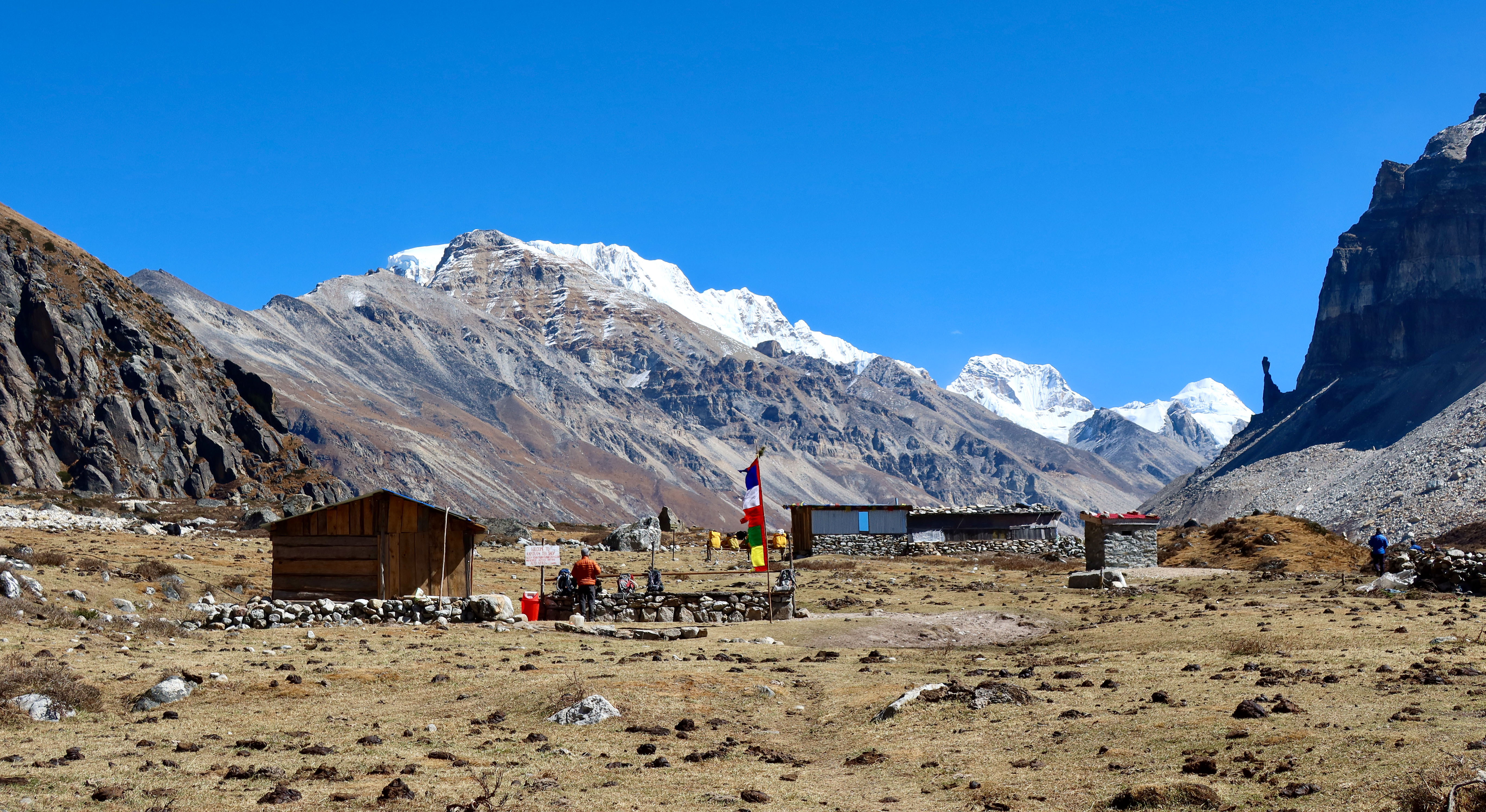
Lonak en route to Kanchenjunga North Base Camp Trek.
Attractive Landscapes.
The Kanchenjunga Base Camp Trek's diverse and stunning landscapes provide a spectacular sight to behold. Trekkers get to experience cultivated land and beautiful woodlands, including the picturesque settlement of Mitlung, as they begin their trek in the subtropical lowlands. The lush flora and vivid green terraced rice fields combine to create a peaceful and wonderful scene. The scenery changes to thick rhododendron woods as the route ascends. These woodlands, especially those near the settlement of Chirwa, pop into vivid red, pink, and white colours in the springtime.
Trekkers ascend farther to the alpine meadows of Ghunsa and Kambachen. With the majestic Himalayas as a background, these meadows, covered with wildflowers, provide magnificent views. With its traditional homes and fluttering prayer flags, the village of Ghunsa is especially enchanting. The high-altitude portions of the trek provide incredible perspectives of rocky landscapes and glacier moraines. The Yalung Glacier, which lies close to South Base Camp, is a spectacle to behold because of its immense sheet of ice.
The North Base Camp provides panoramic views of the Kanchenjunga massif, which includes the spectacular peaks of Kanchenjunga, Yalung Kang, and Jannu. Offering stunning views of the surrounding mountains, the Sele Le Pass is yet another attraction. Trekkers may get a spectacular view of deep valleys and snow-capped peaks from this vantage point. The trek gains an element of adventure since the pass is a thrilling traverse. With its isolated settlements and breathtaking scenery, the Olangchung Gola region provides an exceptional scenic and cultural experience.
Experience the tranquil beauty of this less-visited location while trekking through historic monasteries. The Kanchenjunga Base Camp Trek offers stunning fresh scenery on every stage. The trek offers a visual feast, ranging from colourful woods and verdant valleys to high-altitude meadows and glacier landscapes. The trek is one of Nepal's most distinctive and unforgettable experiences because of the varied and constantly changing landscape.
Photography and Camping.
For those who love photography, the Kanchenjunga Base Camp Trek is a photographer's dream. There are countless possibilities to photograph breathtaking scenery, a wide variety of wildlife, and lively local cultures throughout the trek. Photographers can capture the tranquil beauty of rural Nepal starting with the terraced fields and lush woods in Taplejung. The springtime rhododendron forests provide trekkers with an explosion of colour that makes for striking photographs.
Wide-angle landscape photography is best enjoyed from the alpine meadows around Ghunsa and Kambachen, which provide expansive vistas of the Himalayas. A photo's backdrop is always spectacular, especially with the dramatic terrains of the Yalung Glacier and the majestic peaks of the Kanchenjunga massif. Camping on the Kanchenjunga Base Camp Trek provides an extra dimension of adventure. Trekkers may camp in intriguing locations such as Ramche, where the surrounding peaks provide a wonderful perspective.
Higher altitude camping locations, like Lhonak, provide a beautiful night sky ideal for observing stars. A once-in-a-lifetime experience is to see the Milky Way cross the Himalayan peaks. Additionally, camping enables trekkers to fully appreciate the region's beautiful scenery and peacefulness. The quiet surroundings and pure nature provide an ideal escape from daily life. The Kanchenjunga Base Camp Trek provides outstanding photography and camping opportunities, whether you're shooting the early sunrise hitting the peaks or a night filled with stars sky.
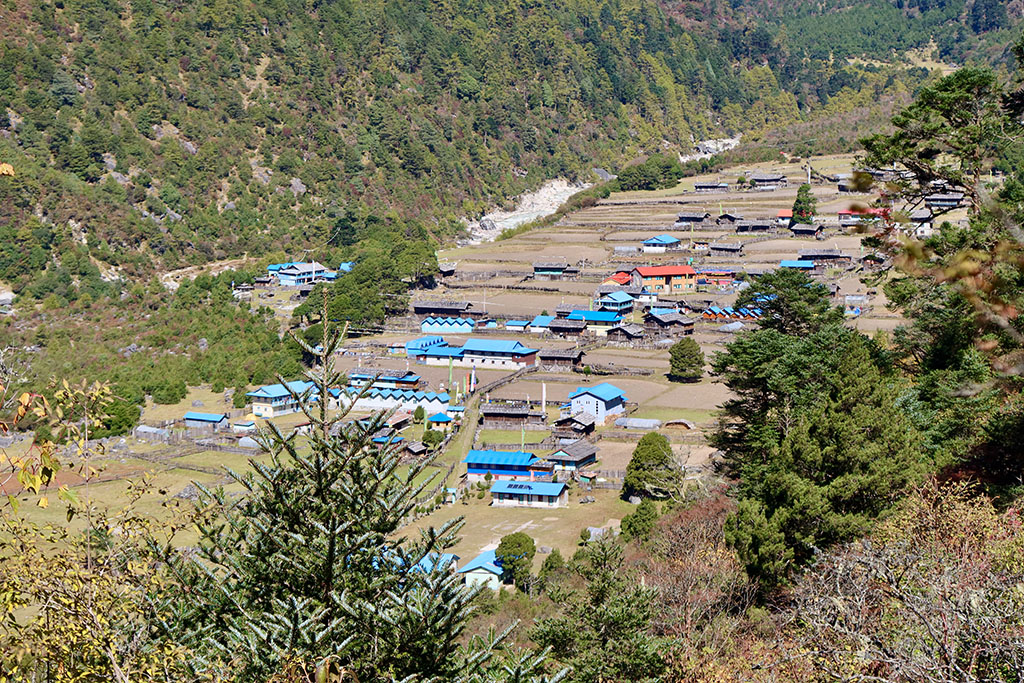
wonderful Ghunsa Village one of the most beautiful Sherpa Village KBC North BC Route.
Indulge in the Tradition and Culture of the Kanchenjunga Region.
The Rai and Limbu inhabitants predominate in the trek's lower sections. The rich cultural legacy and traditional dances of these ethnic communities are well-known. The adventure gains cultural richness from its colourful festivals and distinctive customs. The Sherpa community is increasingly noticeable as the trek ascends, particularly in settlements like Ghunsa and Kambachen. Sherpas are well known for their friendliness and expertise in mountaineering.
The trek gains spiritual importance from the Buddhist temples and prayer flags that frequently appear there. The Tibetan-influenced Bhutia population also lives at higher altitudes. Their traditional dwellings reflect their rich cultural craftsmanship, frequently including elaborate woodwork. Trekkers can gain insight into the customs of these communities by visiting historic monasteries. Furthermore, the trail goes past the Gurung and Magar communities.
Recognized for their bravery as Gurkha warriors, these groups also add to the region's rich cultural diversity. Trekkers gain a broader knowledge of Nepal's cultural variety by interacting with various ethnic groups during the Kanchenjunga Base Camp Trek. The combination of customs, languages, and traditions encountered along the route transforms the trek into a cultural adventure as well as an exploration through incredible landscapes.
Local Festivals and Cultural Practices.
Discovering local festivities and customs enhances the Kanchenjunga Base Camp Trekking experience. Trekkers get to experience the vivid customs of the Limbu and Rai communities. The Limbu people celebrate the harvest season with traditional dance, singing, and rituals known as the Chasok Tangnam festival. A significant occasion for the Rai individuals is the Sakela festival, which features complex dances that narrate tales of origin and community. These dances referred to as Sakela Sili, are done while dressed colourfully, attracting viewers with their exhibition.
Sherpa and Tibetan-influenced Bhutia people in higher elevations celebrate Buddhist holidays such as Losar (Tibetan New Year). With prayers, ceremonies, and colourful dances, monasteries become festive centres. During these holidays, trekkers are invited to partake in the celebrations, demonstrating the Sherpas' warmth and hospitality. The Sherpa community's unique Dumji festival is another attraction. Festivals include mask dances and celebrations to honor Guru Rinpoche's birth anniversary.
It is an especially vibrant period in the communities of Ghunsa and Kambachen. The trek also offers an insight into customs and daily life. Mani walls, chortens, and prayer flags are typical sights that reveal the profound spiritual beliefs of the people living there. An essential component of their cultural expression is the practice of traditional crafts like wood carving and textiles.
Customs and Daily Lifestyles.
In the lower regions, the Rai and Limbu communities follow traditional agriculture. Farming, raising animals, and making traditional items are the main activities of their everyday lives. Observing their diligent work on terraced fields reveals details about their serene relationship with the natural world. Further north, the Bhutia and Sherpa populations exhibit unique traditions rooted in Tibetan Buddhism. Prayer flags, chortens, and mani walls line the streets of villages such as Ghunsa and Kambachen.
Everyday activities for the inhabitants include praying in groups at monasteries and spinning prayer wheels. Their style of life is based on these spiritual activities. One further important consideration is traditional clothing. Women frequently display their ethnic origins through vibrant clothing and jewellery. Men may be seen wearing traditional hats and jackets, particularly at festivals and key occasions. In many societies, craftsmanship has significant importance. Local craftsmen create stunning handcrafted wares, ranging from woven linens to complex wood sculptures.
As a reflection of the talents inherited from previous generations, these crafts are not only useful but also have cultural importance. Comprehending these traditions and ways of life offers a deeper insight into the many cultures that one might experience during the Kanchenjunga Base Camp Trek. Amidst the breathtaking scenery, the adventure transforms into an immersive experience that showcases the distinct customs and daily routines of the locals.
Meals and Accommodations on Kanchenjunga Base Camp Trek.
Accommodations along the Route.
Along the Kanchenjunga Base Camp Trek, trekkers can choose from a range of accommodation alternatives. Basic tea houses to luxurious lodges, all offer the necessities for a comfortable and relaxing stay. In the lower sections, basic yet pleasant accommodation is available in tea houses in communities such as Taplejung and Mitlung. These tea houses provide simple accommodations with common restrooms and kitchens. The welcoming hosts frequently serve local dinners, offering trekkers a taste of traditional cuisine. As the trail ascends, hotels at Ghunsa and Kambachen provide more pleasant accommodations. The dining halls of these lodges provide a variety of cuisines to trekkers, and some of the private rooms have private bathroom facilities.
After a long day of trekking, guests can relax in the cozy common rooms of the hotels, which frequently have fires. For those who want a deeper relationship with nature, camping is an additional choice. Campsites are available for trekkers in locations like Ramche and Lhonak. These locations provide amazing perspectives of the surrounding glaciers and peaks. Our Trekking organization can organize guided camping treks with full assistance, or you may rent camping gear in Kathmandu. There are few possibilities for accommodation in higher altitude areas, so making reservations in advance is crucial. Tea houses in these places are more basic yet they provide a comfortable bed and delicious food. These accommodations' simplicity enhances an authentic trekking experience.
Meals along the Route.
On the Kanchenjunga Base Camp Trek, trekkers may enjoy a range of meals. To keep trekkers energized, tea shops and hotels serve substantial and nourishing meals. Dal Bhat, a Nepalese cuisine consisting of lentil soup, rice, and veggies, is one example of a typical dinner. This everyday meal is well-known for providing balanced nutrition and enhancing energy levels. Aside from dal bhat, trekkers may get momos, which are Tibetan-style dumplings filled with veggies or meat. Frequently, hot dipping sauces are offered alongside these delicious pieces.
There is a wide variety of breakfast alternatives, such as cereal and eggs or Tibetan bread with jam or honey. Chapatis and pancakes are also popular, making for a filling breakfast before a day of trekking. Menus may get more limited as you go further up the trail, but hearty and satisfying meals are still available in villages like Ghunsa and Kambachen. There is always fried rice, soups, and noodles to choose from, as well as warm drinks like tea and coffee. Locally sourced foods offer both freshness and authenticity. Along with sampling locally grown, seasonal veggies, trekkers may also enjoy the local specialty, yak cheese. If certain dietary requirements are known in advance, they are usually handled, however options may be more limited at higher elevations.
Eating lunch with locals and other trekkers enhances the cultural experience. Tea houses and lodges include community dining rooms where people gather to share delicious meals and conversations about their excursions. These spaces are warm and inviting. Along with providing energy for the trek, the cuisine at Kanchenjunga Base Camp Trek delivers an excellent sample of the local hospitality and culture. Every meal becomes a component of the trek and adds to the overall experience of trekking.
Tips on Meals and Drinks.
Hydration is essential for the Kanchenjunga Base Camp Trek. To protect yourself from waterborne infections, always drink boiling or filtered water. Make sure you have a dependable way to purify your water while on the trek by packing pills or a filter. Choose freshly made cuisine from tea shops and lodges for your meals. One basic food that is good for trekkers is Dal Bhat; it is filling and full of energy. Add some variety and extra nourishment to your diet by consuming vegetables that grow nearby. A delicious and high-energy snack is yak cheese, a local deliciousness.
Avoid heavy, oily meals that might cause gastrointestinal problems. On days when trekking is tough, stick to simple, high-calorie meals to sustain energy levels. Let people know if you have any special dietary requirements ahead of time so that the right meals can be provided. Tea and coffee are popular hot beverages that keep you warm. Herbal drinks are excellent for acclimation and calming the digestive system, particularly ginger tea. Throughout the Kanchenjunga Base Camp Trek, these tips will keep you healthy and motivated.
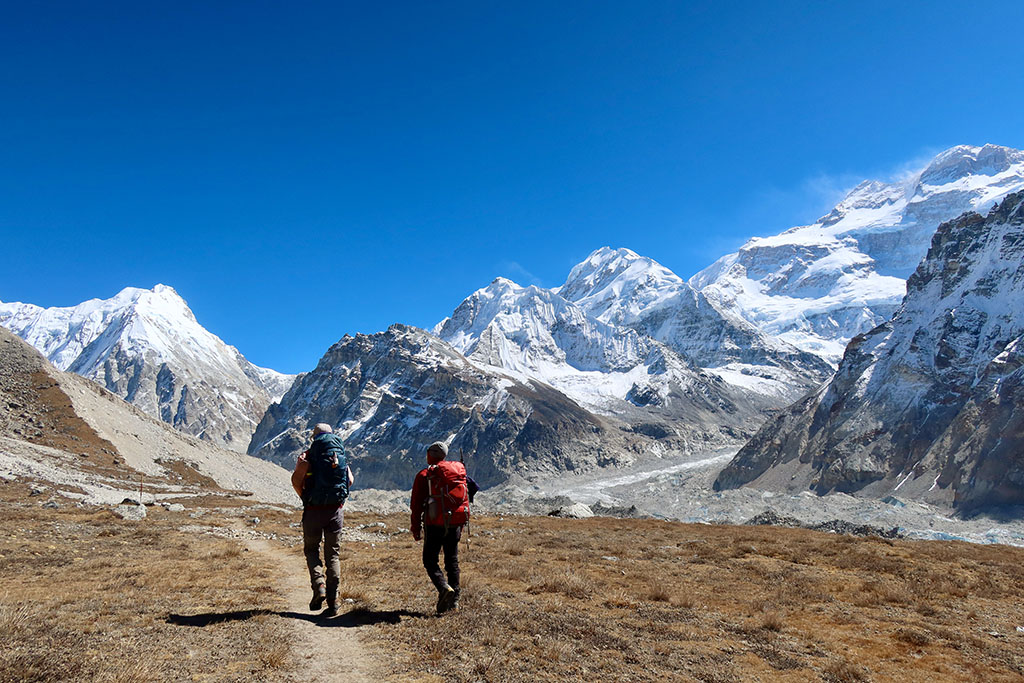
En route to Kanchenjunga North Base Camp Trek and Kanchenjunga North View.
Kanchenjunga Base Camp Trek Difficulty Level.
The Kanchenjunga Base Camp Trek is noted for its difficulty level ranging from moderate to challenging, making it ideal for experienced trekkers. Long, exhausting days filled with steep ascents and descents across isolated, wild landscapes define the trek. Elevations as high as 5,143 meters at North Base Camp pose a serious risk to health and safety, necessitating careful acclimatization to prevent altitude sickness. The trek becomes more difficult because of the unpredictable weather. Trekkers must be extremely fit and well-equipped with the right gear. The route's remoteness and limited infrastructure highlight even more how important stamina is.
Altitude Sickness.
The Kanchenjunga Base Camp Trek's high elevation makes altitude sickness a real risk. The likelihood of developing Acute Mountain Sickness (AMS) rises when you trek over 3,000 meters. Headaches, nausea, and vertigo are some of the symptoms. To reduce danger, ascend gradually and allow for enough acclimatization. To get used to the thin air, spend a few more days at higher elevations, such as Ghunsa. Your body will adjust more quickly if you stay hydrated and avoid overdoing it. In extreme situations, returning to lower elevations is essential for healing. It could also be helpful to bring altitude sickness medicine and speak with a healthcare professional before the trek. The secret to a safe trekking excursion is being mindful and well-prepared.
Rugged Terrain.
The Kanchenjunga Base Camp Trek is well-known for its difficult terrain, which adds to the challenge and attractiveness. Trekkers go across several types of terrain, including steep, rocky routes, terraced farmland, and deep woods. The track has several climbs and descents, and each step is difficult due to narrow routes and hard rocks. Trekkers discover a familiar route in the lower regions, but as they ascend, the conditions become increasingly difficult. The trail may be dangerous and uneven at times, especially after a wet season when it is muddy and slick. The high-altitude sections, especially those close to the base camps, are more challenging because of their rugged, uneven terrain and lack of flora.
Maintaining balance and endurance are necessary when traversing rivers and navigating routes filled with big stones. The altitude and rugged terrain may be exhausting therefore trekking poles are important for balance and support. Wearing the right shoes is crucial to managing the changing weather and avoiding injuries. Overall, the Kanchenjunga Base Camp Trek's tough terrain requires physical endurance and careful preparation, but it rewards trekkers with astounding, pristine scenery and a sense of accomplishment.
Fluctuating Weather.
One of the primary difficulties of the Kanchenjunga Base Camp Trek is the unpredictable weather. Because of the trek's varied terrain and elevations, the weather could become inconsistent. Trekkers should expect reasonably warm temperatures in the lower sections, including Taplejung and Mitlung, although the weather can change unexpectedly. Conditions change more dramatically as you go up. Higher elevations, such as Ghunsa and Kambachen, get more frequent snowfall and colder temperatures than lower elevations, which frequently bring milder temperatures and rain. Unpredictable weather with sudden thunderstorms and temperature falls is common in the region around the base camps, notably Ramche and Lhonak. There are times of intense rain or snow in the area due to the effect of the monsoon and winter seasons. This unpredictability may impact trail conditions, resulting in slick and difficult terrain.
Preparing for the Kanchenjunga Base Camp Trek.
It is necessary to prepare thoroughly before starting the Kanchenjunga Base Camp Trek. Make sure you are in peak physical condition before taking on the difficult terrain of the Himalayas. Regular hiking and cardiac workouts might help you gain stamina and strength. Make sure you have top-notch equipment for the range of weather conditions you'll experience, from the lush Taplejung forests to the high altitudes of Pangpema. Bring necessary items such as trekking poles, strong boots, and layers of clothes. Respect cultural sensitivity by researching local practices in distant regions such as Ghunsa and Cheram. Obtain the essential permissions and consider travel insurance for your Kanchenjunga Base Camp Trekking.
Choosing the Best Season.
Understanding the seasons is essential to a successful Kanchenjunga Base Camp Trek. The proper weather pattern provides you with a complete bundle of natural delights as well as pleasant trekking. Beautiful views of the Kanchenjunga Region are possible due to the crisp and pristine weather. Knowing when is best to trek Kanchenjunga not only guarantees the greatest trekking experience but also protects you from any natural disasters.
Spring (March to May).
The Kanchenjunga Base Camp Trek is especially colourful this season, with routes in Taplejung and Amjilosa dotted with blossoming rhododendrons. Clear sky provides for unobstructed views of the neighbouring peaks, and pleasant temperatures make trekking enjoyable. The weather is still lovely as you ascend past Ghunsa and beyond, so now is the perfect time to take pictures and take in the natural beauty of the region. The local wildlife is also more active in the spring, making it possible to see rare species in the forests surrounding Kambachen.
Autumn (September to November)
The Kanchenjunga Base Camp Trek has some of the clearest atmospheres of the year in the autumn, making it ideal for photographing amazing panoramas from spots like as Lhonak and Pangpema. The weather is consistent, with crisp, chilly air, which improves the whole trekking experience. There is less crowding on the trails that pass through settlements like Ghunsa and Khangpachen, making for a peaceful trek. As this is the season of harvest in the area, your trek will have a strong cultural component due to the local festivals and cultural activities you'll experience in settlements like Sekathum.
Monsoon (June to August)
Heavy rains during the monsoon season make the trails surrounding Chirwa and Mitlung muddy and challenging to navigate on the Kanchenjunga Base Camp Trek. However, the abundant greenery is at its peak, producing a vividly green landscape. Because there are usually fewer trekkers during this time of year, the trek offers peace even if visibility may be limited owing to frequent cloud cover. Although there are sometimes leeches and slick trails, the rivers and waterfalls along the route are at their most forceful and provide a distinct form of natural beauty in places like Tapethok and Yamphudin.
Winter (December to February).
Winter turns the Kanchenjunga Base Camp Trek into a snowy trek through densely packed snow, covering high-altitude regions like Pangpema and Lhonak. Particularly in the highest parts of the excursion, the chilly weather makes this season difficult. However, bright winter skies offer some of the greatest views of the Kanchenjunga range. There are fewer trekkers as you trek through villages like Ghunsa and Cheram, providing a more personal encounter with the peaceful snow-covered surroundings. Those who decide to trek during this period must be prepared and have the appropriate equipment.
Permits essential on Trek to Kanchenjunga Base Camp.
It is necessary to get a Restricted Area Permit to trek to the inaccessible parts of Kanchenjunga, such as Ghunsa and Yamphudin. To regulate and keep an eye on trekkers' movement in sensitive border regions, a permit is necessary. The RAP costs USD 20 per week for foreign trekkers and a lower charge for locals. In certain regions, Solo trekking is not allowed; instead, permits must be obtained from a recognized trekking agency. To support sustainable tourism in the Kanchenjunga Conservation Area, the RAP makes sure that the region's distinctive natural and cultural heritage is preserved.
Kanchenjunga Conservation Area Permit (KCAP).
The Kanchenjunga Conservation Area Permit (KCAP) is necessary to enter the Kanchenjunga Conservation Area, which includes popular trekking destinations including Taplejung, Sekathum, and Cheram. For trekkers from outside Nepal, this permit costs NPR 2,000; for natives of Nepal, it costs NPR 100. The KCAP charge makes a direct contribution to conservation efforts by funding programs that save endangered species and encourage sustainable growth in the surrounding regions. Trekkers have to show this permit at several checkpoints along the way to ensure that the beauty of the region is preserved and conservation laws are followed.
Trekker’s Information Management System (TIMS) Card.
A TIMS card is another necessary permit for the Kanchenjunga Base Camp Trek, which is intended to keep track of all trekkers in Nepal for safety and security purposes. International trekkers must pay USD 20 for group treks and USD 10 for solo treks; SAARC nationals must pay NPR 600. Suketar and Taplejung entrance points have TIMS checks. This card guarantees that trekkers' itineraries are closely watched for their safety, assists authorities in managing trekking routes, and gives vital information for search and rescue efforts.
Physical and Mental Preparation.
The diverse landscape of the Kanchenjunga Base Camp Trek necessitates significant physical training. There are robust rises and descents during the trek, especially in the most challenging sections around Sele La Pass and the approach to Lhonak. Regular cardiovascular activity, such as swimming, cycling, or running, is essential for building endurance. It's equally crucial to strength-train your legs, core, and upper body to withstand the weight of your backpack and the exhaustion of lengthy trekking days. Your body will be ready for the challenges of the trek if you prepare on rough terrain, especially in high-altitude regions where stamina is put to the test.
For the Kanchenjunga Base Camp Trek, the mental aspect is just as important as the physical. The trek demands a strong mental attitude because of its distant and secluded nature, especially in locations like Ghunsa and Pangpema. It's important to be ready for lengthy trekking days, severe weather, and the isolation of remote mountain routes. Exercises for mental strength, mindfulness, and meditation can assist develop the mental toughness necessary to maintain concentration and optimism throughout the entire adventure. You can reduce stress and boost confidence by familiarizing yourself with the trek's goals and mentally imagining the obstacles you will face each day. Being mentally prepared will improve your experience in general and enable you to completely appreciate the challenges and beauty of the Kanchenjunga Base Camp Trek.
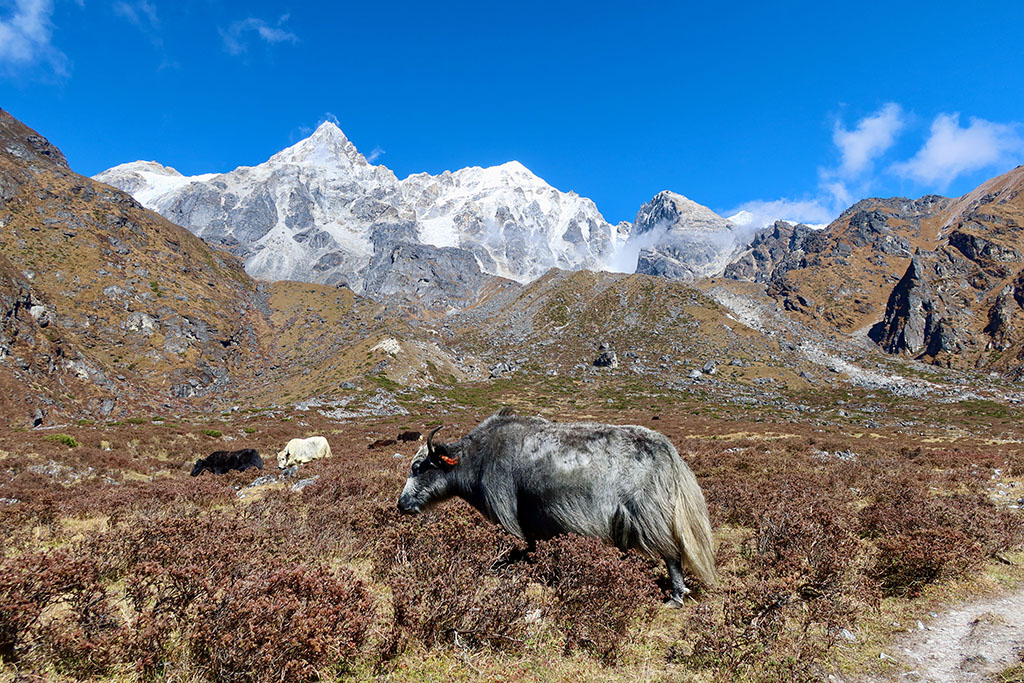
Wonderful Yak Grazing Landscapes Kanchenjunga South Base Camp side.
Exploring Kanchenjunga South Base Camp.
Trekking to Kanchenjunga South Base Camp provides an extraordinary experience. Trekkers begin at Yamphudin and progressively rise through beautiful woods and terraced farms, passing past villages such as Tortong. As you get closer to Ramche, the terrain gets tougher, but the reward is the amazing vistas of the Yalung Glacier. Enormous views of Kanchenjunga's massive south face greet you when you arrive at Kanchenjunga South Base Camp, which is close to the magnificent Oktang viewpoint. With fewer visitors than its northern cousin, this base camp offers an idyllic setting perfect for observation and taking in the surrounding Himalayan majesty.
Route to South Base Camp.
The trek to Kanchenjunga South Base Camp is captivating taking you through an abundance of sceneries. Beginning in Taplejung, trekkers pass through charming settlements like as Suketar and Chirwa before gaining elevation and entering verdant woods at lower altitudes. The route then passes through isolated places like Mitlung and Kambachen, where trekkers may take in the incredible views and get a taste of the local way of life. After trekking through alpine meadows to reach Ramche, trekkers arrive at the South Base Camp near Oktang. The route offers a unique experience as it blends cultural immersion with stunning Himalayan scenery, ending in a stunning view of Kanchenjunga's southern face.
Landmarks and Viewpoints.
Exploring the South Base Camp on the Kanchenjunga Base Camp Trek takes trekkers through some of the most astounding sites and viewpoints. Through Tortong, the route follows the Simbuwa Khola River, offering a serene atmosphere with verdant forest surroundings. The scenery widens as you get closer to Ramche and you can see the Yalung Glacier for the first place. This amazing sight emphasizes the wild beauty of the region. The last section ends at the South Base Camp, which is close to the Oktang viewpoint, from where the impressive south face of Kanchenjunga offers an impressive view of the surrounding landscape.
Despite its challenges, the trek is noteworthy since this viewpoint provides one of the most amazing vantage points of the Kanchenjunga mountain. Along the route, historic monasteries and sacred locations enhance the cultural experience by combining the Himalayan Mountains' magnificent natural beauty with spiritual themes. Along the route, some landmarks offer spectacular views and increase the impression of history and tradition in this region.
Exploring Kanchenjunga North Base Camp.
Experience the deepest parts of the Himalayas with the Kanchenjunga North Base Camp Trek. The route goes past the isolated community of Ghunsa, which is home to a vibrant traditional Tibetan community. The route continues to ascend until it passes into Lhonak, a high meadow with expansive panoramas of the surrounding peaks. An impressive close-up of the towering north face of Kanchenjunga awaits you as you make your final approach to the North Base Camp at Pangpema, across rocky, glacial surroundings. Trekkers may fully enjoy the majesty and broadness of the third-highest peak in the world from this base camp, which offers an outstanding viewpoint.
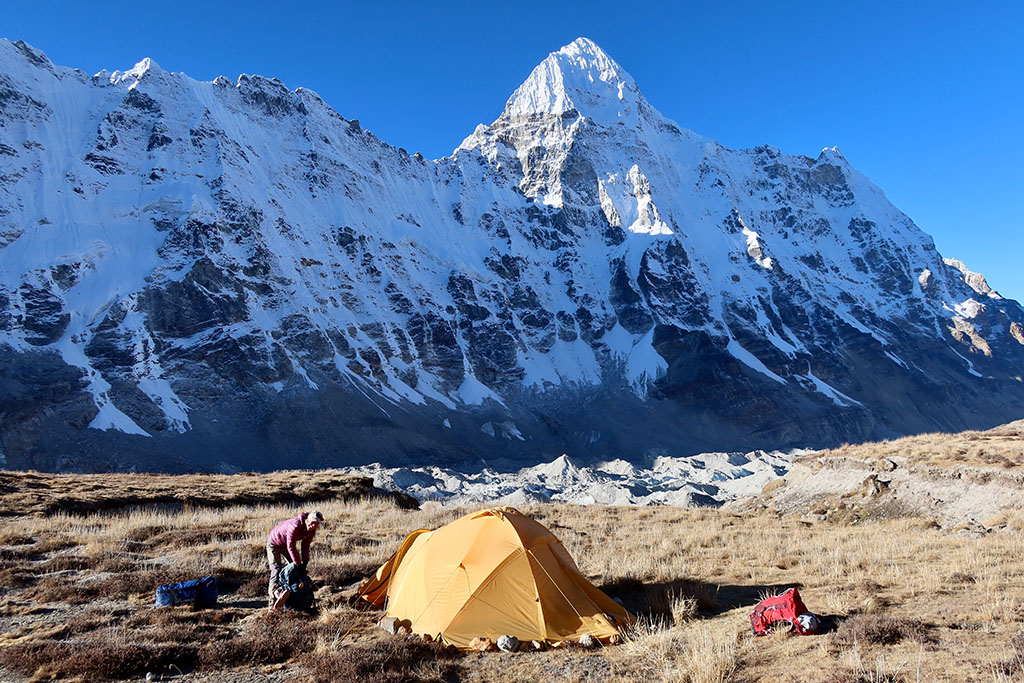
Our Campsite at Kanchenjunga North Base Camp (Pangpema)
Route to North Base Camp.
On the Kanchenjunga Base Camp Trek, the route to North Base Camp passes through a range of challenging terrains. Trekkers begin their adventure in Taplejung and go through verdant woodlands and cultivated farmland. The trail leads to Mitlung and then to Chirwa, where trekkers may enjoy local culture and friendliness. Following Chirwa, the route continues to Sekathum and then Amjilosa, where the terrain gets more challenging. Through thick rhododendron forests, the trekkers continue to Gyabla. There are amazing views and a chance to acclimate along the route to Ghunsa, a notable settlement at a higher altitude. Ghunsa's distinctive beauty and friendly locals give a welcome break.
After leaving Ghunsa, the trail passes over rocky and uneven terrain to Kambachen. There are difficult terrains and glacial moraines to cross from Kambachen to Lhonak. Another important acclimatization location is Lhonak, which has magnificent panoramic views of the neighboring peaks. The last stretch from Lhonak to North Base Camp is challenging, due to steep elevations and harsh terrain. The base camp, located at 5,143 meters, rewards trekkers with stunning views of Mount Kanchenjunga and its adjacent peaks. This challenging route necessitates physical stamina and adequate acclimatization, making it a highlight of the Kanchenjunga Base Camp Trek.
Landmarks and Viewpoints.
Relish incredible vistas of the majestic north face of Kanchenjunga at 5,143-meter Pangpema. This viewpoint on the Kanchenjunga Base Camp Trek is a highlight of the expedition since it provides amazing panoramas of Eastern peaks. The peaceful and secluded location of North Base Camp adds to the experience and fosters a close bond with the natural world. Furthermore, Lhonak, another important viewpoint, offers a magnificent view of the Kanchenjunga glacier alongside its neighboring peaks. The trek from Lhonak to Pangpema is filled with magnificent scenery, including rocky terrain and pristine vistas of the highlands. These sights and perspectives along the Kanchenjunga Base Camp Trek provide trekkers with remarkable experiences of natural beauty and calm.
Historical Landmarks and Sites.
The Kanchenjunga Base Camp Trek offers trekkers wonderful historical landmarks and sites to behold. Ghunsa is a wonderful settlement with historic Buddhist temples covered with colourful prayer flags. Olangchung Gola, one of the area's oldest villages, has traditional Tibetan architecture and historic stupas. The small village of Phale, located further up the trail, features old stone homes with beautiful woodwork carvings. By offering a deeper understanding of the regional culture and history, these historical sights and locations along the Kanchenjunga Base Camp Trek enhance the enjoyment.
Ancient Monasteries and Temples.
Ghunsa village, with its historic monasteries, notably the sacred Ghunsa Gompa, provides a window into the spiritual life of the region for trekkers undertaking the Kanchenjunga Base Camp Trek. This monastery is an important spiritual hub for the neighborhood, decorated with colourful prayer flags and artistic murals. Lungchung Gompa is a significant cultural landmark that preserves ancient religious items and is located in Olangchung Gola, a region renowned for its traditional Tibetan architecture. Trekkers may explore the ancient stone Phale Monastery in Phale town, which is well-known for its exquisitely carved woodwork features and peaceful atmosphere. The Pathibhara Temple, a major Buddhist and Hindu pilgrimage site, is located near Taplejung, another noteworthy trek destination. This temple is well-known for both its religious significance and its expansive views of the mountains in the vicinity.
Historical Trade Routes.
The Kanchenjunga Base Camp Trek takes you over centuries-old trade routes. Olangchung Gola, a historic trading center, was once an active center for exchanging goods between Nepal and Tibet. Its ancient Lungchung Gompa and traditional Tibetan homes, which represent the community's wealthy trading past, help it to preserve its old-world charm. The route continues on and goes into Ghunsa, another important place on these historic trading routes. With its recognizable Ghunsa Gompa, Ghunsa hamlet was an important stopping point for traders making their way through the difficult Himalayan landscape. Due to its advantageous location, the village served as a crucial link in the commerce network that connected different areas.
Conclusion Kanchenjunga Trekking In Eastern Nepal.
The Kanchenjunga Base Camp Trek provides trekkers with a deep grasp of the history, spirituality, and natural beauty of the region. For anybody looking to explore the heart of the Himalayas, this excursion is a must-do since it offers a distinctive combination of adventure and cultural discovery. The stunning peaks, historic monasteries, and lively local culture that one encounters along the route create a lasting impression.
Trekking to Kanchenjunga Base Camp provides a wonderful excursion through one of Nepal's most beautiful and culturally diverse regions. The trek blends a profound cultural immersion with natural beauty, from the spiritual experiences at Ghunsa Gompa and Phale Monastery to the stunning views at Pangpema and Lhonak. The old Tibetan architecture and the long-standing trade networks that formerly grew in the area are visible in the historic settlement of Olangchung Gola.
Trekkers via Taplejung can visit the renowned Pathibhara Temple, which adds a spiritual depth to their trek. Sekathum Monastery's calm atmosphere and Phale Monastery's beautiful wooden carvings showcase the region's rich artistic background.

